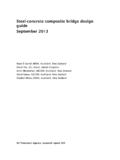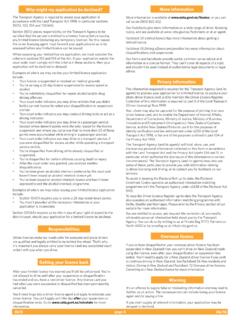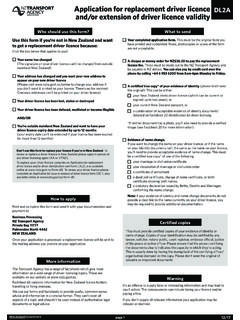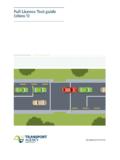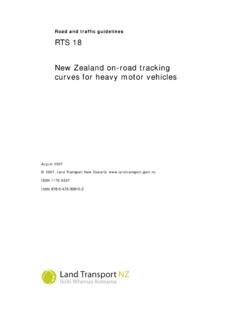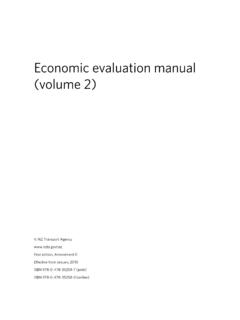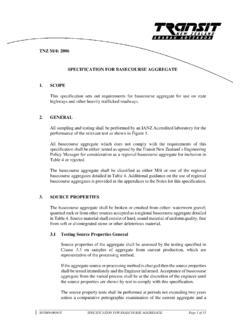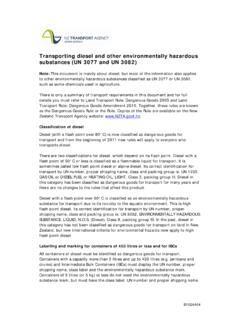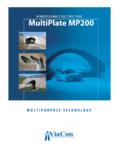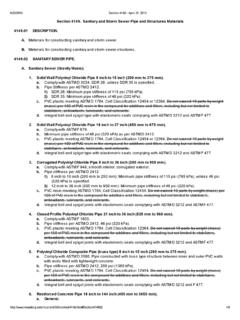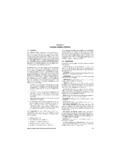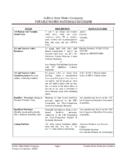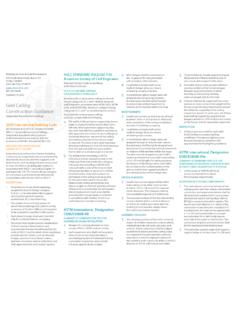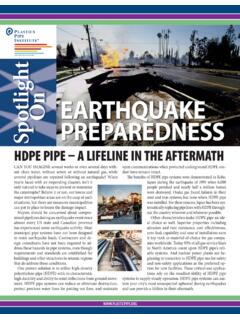Transcription of F/3 Specification for Pipe Culvert Construction
1 NZTA F3: 2010 SP/SF3: 2010 101216 Specification FOR PIPE Culvert Construction Page 1 of 8 Specification FOR PIPE Culvert Construction 1. SCOPE Pipe culverts shall be constructed in accordance with this Specification and in conformity with the lines, levels and cross-sections shown on the drawings. The work shall include: the Construction of trenches; the supply and placement of bedding; the supply and laying of pipes; the jointing of the pipes; the Construction of headwalls, wing-walls, aprons, drops, and intakes and outlet structures where specified; the Construction of connecting and outlet drains; backfill of trenches and reinstatement as specified, the supply of all materials, labour, plant, transport and tools required for the proper completion of the work and testing. Where pipes and are less than 350mm in diameter and laid in a narrow trench, they shall, unless otherwise specified, be laid in accordance with the following standards appropriate for the pipe type: AS/NZS 3725:2007 Design for installation of buried concrete pipes and AS/NZS 2566: buried flexible pipelines.
2 For PVC pipes use; AS/NZS2032 2006 Installation of PVC pipe systems for PVC pipes. For all polyethylene (PE) pipes use AS/NZS2033 2008 Installation of polyethylene pipe systems. Where pipe culverts are to be constructed in any natural river, stream, or waterway in such a way that the passage of fish would be impeded, Part 6 of the Freshwater Fisheries Regulations 1983 must be complied with. 2. MATERIALS Pipe Types The pipes shall conform to the requirements for the class, type of joints, diameter and length shown on the drawings and defined in the job Specification , and shall be one of the following types: Concrete pipes: (a) Concrete pipes shall comply in all respects with the requirements specified in AS/NZS 4058:2007 Precast concrete pipes (pressure and non-pressure) and designed and installed to NZS/AS 3725 2007: Design for installation of buried concrete pipes; Corrugated steel or aluminium pipes of any of the following types: (a) Aluminium and steel structures (or conduits) complying with AS/NZS 2041 1998: buried Corrugated Metal Structures, and :2010 buried Corrugated structures - Helically formed sinusoidal pipes.
3 NZTA F3: 2010 SP/SF3: 2010 101216 Specification FOR PIPE Culvert Construction Page 2 of 8 Aluminium pipes complying with relevant clauses in AS/NZS 2041 as above together with AASHTO M219: Aluminium Alloy Structural Plate for Field Bolted Conduits and AASHTO Standard Specifications for Highway Bridges, Section 12. (b) Nestable corrugated steel pipes complying with AS/NZS 2041: 1998 buried Corrugated Metal Structures, and AS/NZS :2010 buried Corrugated structures - Helically formed sinusoidal pipes. (c) Helical lock-seam corrugated aluminium pipes complying with relevant clauses in NZS 4406:1986 as above together with AASHTO M196: Standard Specification for Corrugated Aluminium Pipe for Sewers and Drains and AASHTO M197 Standard Specification for Aluminium Alloy Sheet for Corrugated Aluminium Pipes. (d) Helical lock-seam corrugated steel pipes complying with relevant clauses in AS2041 as above together with NZS4406 1986: Helical lock seam corrugated steel pipes design & installation.
4 PVC pipes and fittings to Class SN4 or SN6 as defined in AS/NZS 1260 2009: PVC pipes and fittings for drain, waste and vent applications, and UPVC Pipes and Fittings to AS 1254 2010: UPVC pipes and fittings for storm and surface water applications designed and installed to AS/NZS :1998 buried flexible pipelines and buried flexible pipelines. Polyethylene pipes manufactured to AS/NZS 4130 2009: Polyethylene (PE) pipe systems for pressure applications and installed to 1998: buried flexible pipelines and AS/NZS : 2002 buried flexible pipelines. Glass reinforced plastic pipes manufactured to AS 3571: 2009 Glass reinforced thermo plastic (GRP) systems based on unsaturated Polyester (UP) resin Pressure and non-pressure drainage and sewage and designed and installed to AS/NZS 2566: buried flexible pipelines (parts 1 and 2). Perforated polyethylene pipes manufactured to Type 1 or Type 2 defined in AS 2439:2007 Perforated plastics drainage and effluent pipe and associated fittings and installed to AS/NZS 2566: buried flexible pipelines (Parts 1 and 2).
5 Polyethylene and polypropylene black or black jacket twin wall or plain wall pipes manufactures to NZS/AS 5065:2005 Polyethylene and polypropylene pipes and fittings for drainage and sewerage application NZTA F3: 2010 SP/SF3: 2010 101216 Specification FOR PIPE Culvert Construction Page 3 of 8 ( and Amendments) and installed to AS/NZS 2566: buried flexible Pipelines (Parts 1 and 2). The Contractor shall produce evidence of the pipes compliance with one of the above clauses if requested by the Engineer. Elastomeric Sealed Joints Rubber rings used in flexible joints shall comply with AS 1646 Elastomeric Seals for waterworks purposes (parts 1, 2 and 3) and shall be of a type approved by the pipe manufacturer for use with the particular joint. Mortar Mortar shall consist of one part of cement to two parts of fine, clean, sharp sand that complies with NZS 3103: 1991 Specification for sands for mortars and plasters measured in dry loose volume, and just sufficient water to make it workable.
6 The mortar shall be mixed either by hand or in an approved mechanical mixer, as required. Any mortar which is not used within 30 minutes of mixing shall be discarded. Timbering and Formwork The Contractor shall be responsible for providing support to all excavations and for all falsework and formwork. 3. EXCAVATION Clearing The Contractor shall remove sufficient vegetation and topsoil to allow pipe laying to proceed without risk of contamination of bedding or backfilling. Trenches Where trenches are required, they shall be cut in such a manner as will ensure that the pipes will be laid true to the depths, grades and lines shown on the drawings. The base of the trench shall not be excavated over the specified dimensions unless directed by the Engineer for the removal of unsuitable material. Unless otherwise specified, trenches shall have a minimum gradient of not less than 1 in 80 and a minimum depth that will ensure that, when the pipes are laid, the distance between the top of the pipes and the finished surface level shall be not less than 1 metre in any place unless otherwise designed for less cover as approved by the Engineer.
7 Support for Excavations The Contractor shall be responsible for providing support to all excavations and for falsework and formwork and shall conform with safety practices and codes of practice issued by the Department of Labour. NZTA F3: 2010 SP/SF3: 2010 101216 Specification FOR PIPE Culvert Construction Page 4 of 8 Inlet and Outlet Drains Inlet and outlet drains shall be cut true to grade and line within the limits of the road reserve or such other limits as are shown on the drawings or directed by the Engineer. These drains shall have a bottom width equal to the external diameter of the pipe or the width of the concrete apron where applicable, and side slopes of one horizontal to two vertical in clay and one horizontal to four vertical in rock. Handling of Excavated Material To avoid any danger to stability of the trench or adjacent buried services excavated material shall be stacked a sufficient distance away from the edge of the excavation and the size of the spoil bank shall be limited.
8 Surplus excavated material shall be disposed of as specified in the specific contract documents or as directed by the Engineer. Unsuitable Foundation Material Where the Engineer considers that the foundation material below the pipes or structures is unsuitable, this material shall be removed to a depth of 600mm or any greater depth as specified by the Engineer. Unsuitable foundation material shall be replaced with approved material placed in layers of 150mm loose depth which shall then be compacted as specified in either the relevant standard or contract documents. Saw Cutting of Existing Asphalt Surfaces Existing asphalt surfaces shall be saw cut prior to excavation where pipes are being placed under existing roads. 4. DEWATERING General The Contractor shall keep the excavations free from water at all times and shall provide all such pumping plant and drainage systems as may be required for this purpose.
9 For small diameter rigid pipes upon release of the pumping the bedding material must be stable to ensure a uniform bedding is maintained. Pipe length is an important parameter if broken backs are to be avoided. Sumps Sumps formed for the purpose of dewatering shall be kept outside the line of the trench and away from foundations as far as possible. When finished with, they shall be backfilled and consolidated in layers with suitable fill or concrete. NZTA F3: 2010 SP/SF3: 2010 101216 Specification FOR PIPE Culvert Construction Page 5 of 8 5. BEDDING LAYING AND JOINTING PIPES Bedding Unless otherwise detailed in the specific contract documents or to an appropriate standard as approved by the Engineer, all bedding material shall satisfy the requirements in AS/NZS 3725:2007 Design for installation of buried concrete pipes and AS/NZS 2566 buried flexible pipelines (Parts 1 and 2).
10 Irrespective of the method of bedding used, the bedding adjacent to the pipe joints shall be recessed as necessary to ensure that the whole of the barrel length of the pipe makes uniform contact with the prepared bedding. Laying and Jointing Pipes All pipes shall be laid in accordance with the relevant standards, the manufacturer s instructions and good trade practice. Pipe jointing shall be carried out in such a manner that the finished joints are watertight and present a smooth invert surface. For concrete pipes, the spigot and the inside of the socket of pipes shall be clean before jointing. Rubber rings for flexible joints shall be free of dust, grease or dirt. The rubber rings shall be mounted evenly on the extreme end of the spigot and the pipe lined up truly concentric with the pipes already laid. The spigot shall then be forced into the socket leaving a gap between the socket shoulders and the spigot of between 5 and 10mm, or as recommended by the manufacturer, care being taken to maintain the pipes concentric.
